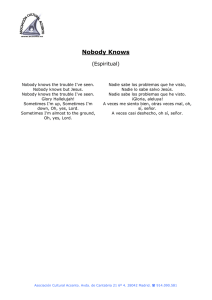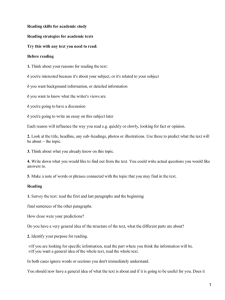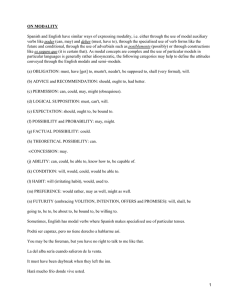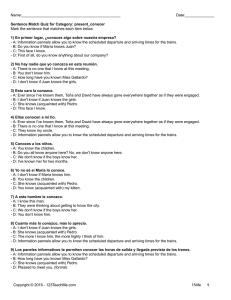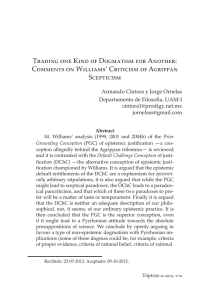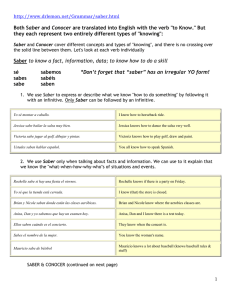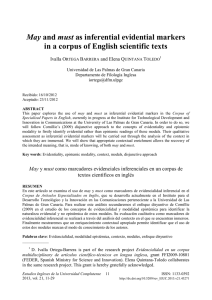A Five-Valued Logic and a System
Anuncio
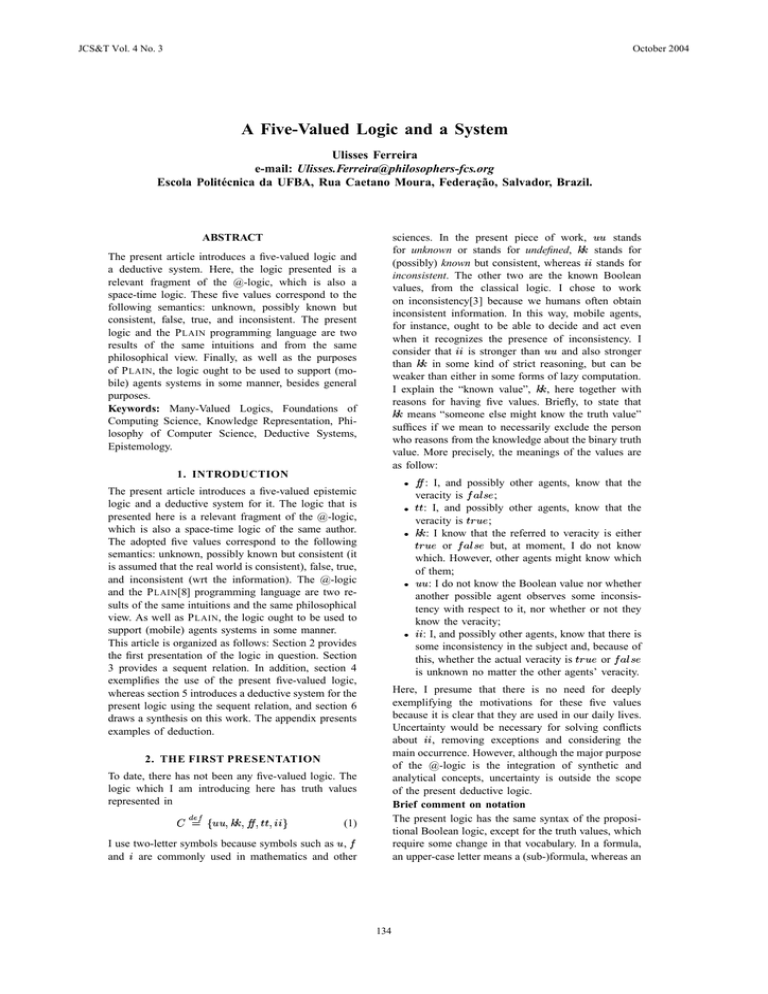
JCS&T Vol. 4 No. 3 October 2004 A Five-Valued Logic and a System Ulisses Ferreira e-mail: [email protected] Escola Politécnica da UFBA, Rua Caetano Moura, Federação, Salvador, Brazil. ABSTRACT stands sciences. In the present piece of work, stands for for unknown or stands for undefined, (possibly) known but consistent, whereas stands for inconsistent. The other two are the known Boolean values, from the classical logic. I chose to work on inconsistency[3] because we humans often obtain inconsistent information. In this way, mobile agents, for instance, ought to be able to decide and act even when it recognizes the presence of inconsistency. I and also stronger consider that is stronger than in some kind of strict reasoning, but can be than weaker than either in some forms of lazy computation. I explain the “known value”, , here together with reasons for having five values. Briefly, to state that means “someone else might know the truth value” suffices if we mean to necessarily exclude the person who reasons from the knowledge about the binary truth value. More precisely, the meanings of the values are as follow: The present article introduces a five-valued logic and a deductive system. Here, the logic presented is a relevant fragment of the @-logic, which is also a space-time logic. These five values correspond to the following semantics: unknown, possibly known but consistent, false, true, and inconsistent. The present logic and the P LAIN programming language are two results of the same intuitions and from the same philosophical view. Finally, as well as the purposes of P LAIN, the logic ought to be used to support (mobile) agents systems in some manner, besides general purposes. Keywords: Many-Valued Logics, Foundations of Computing Science, Knowledge Representation, Philosophy of Computer Science, Deductive Systems, Epistemology. $ (1) I use two-letter symbols because symbols such as , and are commonly used in mathematics and other $ " " ! " $ " ! " Here, I presume that there is no need for deeply exemplifying the motivations for these five values because it is clear that they are used in our daily lives. Uncertainty would be necessary for solving conflicts about , removing exceptions and considering the main occurrence. However, although the major purpose of the @-logic is the integration of synthetic and analytical concepts, uncertainty is outside the scope of the present deductive logic. Brief comment on notation The present logic has the same syntax of the propositional Boolean logic, except for the truth values, which require some change in that vocabulary. In a formula, an upper-case letter means a (sub-)formula, whereas an " To date, there has not been any five-valued logic. The logic which I am introducing here has truth values represented in ! 2. THE FIRST PRESENTATION : I, and possibly other agents, know that the ; veracity is : I, and possibly other agents, know that the ; veracity is : I know that the referred to veracity is either or but, at moment, I do not know which. However, other agents might know which of them; : I do not know the Boolean value nor whether another possible agent observes some inconsistency with respect to it, nor whether or not they know the veracity; : I, and possibly other agents, know that there is some inconsistency in the subject and, because of or this, whether the actual veracity is is unknown no matter the other agents’ veracity. 1. INTRODUCTION The present article introduces a five-valued epistemic logic and a deductive system for it. The logic that is presented here is a relevant fragment of the @-logic, which is also a space-time logic of the same author. The adopted five values correspond to the following semantics: unknown, possibly known but consistent (it is assumed that the real world is consistent), false, true, and inconsistent (wrt the information). The @-logic and the P LAIN[8] programming language are two results of the same intuitions and the same philosophical view. As well as P LAIN, the logic ought to be used to support (mobile) agents systems in some manner. This article is organized as follows: Section 2 provides the first presentation of the logic in question. Section 3 provides a sequent relation. In addition, section 4 exemplifies the use of the present five-valued logic, whereas section 5 introduces a deductive system for the present logic using the sequent relation, and section 6 draws a synthesis on this work. The appendix presents examples of deduction. 134 JCS&T Vol. 4 No. 3 October 2004 upper-case Greek letter denotes a multiset of formulae of this logic. The five values Initially, I define the strongest five-valued equivalence in the following way: of truth (here, for better clarity, I shall use each value with a single-letter symbol in the following paragraph): 5 5 f,1 knows that something is false ; t,1 knows that it is true ; u, 1 does not know because 1 does not have sufficient knowledge ; i, 1 does not know because it obtains inconsistency ; k, 1 knows, although I do ; kf, 1 knows f because 2 not know which in knows that it is false ; kt, 1 knows t because 2 knows that it is true ; ku, 1 knows u because 2 does not know because 2 does not have sufficient knowledge ; ki, 1 knows i because 2 does not know because 2 sees inconsistency ; kk, 1 knows the value because 2 knows, but I do not know which ; kkf, 1 knows f because 2 knows f because 3 knows that it is false ; kkt, 1 knows t because 2 knows t because 3 knows that it is true ; kku, 1 knows u because 2 knows u because 3 does not know because 3 does not have sufficient knowledge ; and so on. The numbers can indicate machines, for instance. 6 5 uu kk ff tt ii 6 5 6 5 uu kk ff tt ii tt ff ff ff ff ff tt ff ff ff ff ff tt ff ff ff ff ff tt ff ff ff ff ff tt 6 5 2 7 7 $ $ 4 6 5 6 5 6 6 5 5 6 fig 1 - the table for the equivalence . 5 6 6 . In and, further, discrimination: the @-logic, is the same as . In this section, I explain a hierarchy of veracity. Essentially, there are two kinds of unknown: “unknown because one does not know the value in the problem domain” ( ) or, alternatively, “unknown because the value is inconsistent” ( ). Thus, in comparison with other logics such as Belnap’s, which can be roughly may be interpreted as “the shown below, while and are not inconsistent value”, the present can be the opposite of , opposite values as depending on the negation in question. Briefly, there are two relative views and sets of the operators or connectives: ontological and epistemic. The present work is epistemic but the logic also directly deals with the concepts of true and false, not necessarily the possible knowledge about them. Whereas form a subset of connectives (operators), form another subset of them. To simplify the language during the presentation, I shall refer to them as “ontological” and “epistemic” operators or connectives. This classification is relative. Further, I use “connectives” and “operators” with the same meaning, for any reaand , i.e., both soning. Thus, whereas and formulae are evaluated as are valid and make use of the ontological negation. From the epistemic point of view, to propagate inconsistency, I simply state , which means that “if a formula is inconsistent, so is its negation”. As an example, if a machine’s father (which is another and the machine’s machine) states the predicate , mother (another machine) states the predicate the machine has some inconsistent knowledge, i.e. . If, latter, the machine is told that its knowledge is wrong, and it negates both what its father and mother said, the machine will still have inconsistent knowledge. Another epistemic negation of would be the value “consistent”, which is absent from the set of values that I chose for I do not regard a specific value for consistency as interesting for my purpose. I can even represent the following structure 5 5 6 6 In general, a truth value is in the form where is a natural number that indicates the number of occurrences of , and is a single letter in u k f t i , which corresponds to a value of the logic being presented. As a syntax sugar, one can also consider the , e.g. kkkkt ttttt and kkku uuuu. The form predicates u, k and i are modal operators. For example, in [9], the general form for is explicitly indexed by the entity that has the knowledge. 9 ; < ; > @ ; 2 A 4 " ( & ( ( 0 0 . . 0 E E F F 6 Although the @-logic is epistemic and knowledge is a relative notion, in the following figure, the first set is more ontological while the second set is more epistemic, in the sense that the first set is with respect to direct knowledge about the referred to objects, whereas some results of the second set are on indirect yields for one is knowledge. For instance, yields the interested in the actual result, whereas information that there is some inconsistency whenever it is the case, i.e. knowledge about the knowledge about existences. . D D 2 & . & . 5 $ While, for a person , sometimes we humans ”, the above hierarchy of state “according to truths allows the representation of any indirect knowledge of this simple kind. There can be a simplified and static view of my five values considering only the last letter as a truth value. 0 7 7 7 7 7 4 7 . I now introduce some connectives of the present logic as follows: 135 JCS&T Vol. 4 No. 3 October 2004 and , as well as both absorption laws, and , hold in accordance with my automatic verifications. Furthermore, distributive laws: and are valid and can be written in this way as the present logic binds conjunctions tighter than disjunctions. and are the same as As the results of and , respectively, when , I can collapse both conjunctions and both disjunctions above in another four-valued logic by dropping and redefine a four-valued implication and equivalence, if I presume that there is no inconsistency. In the logic shown above, a possible interpretation for the operators is with respect to the knowledge on the operands of a (possibly non-logical) arbitrary operation, typically in a programming language context. , the connective If one or more values are in gives its negation, as above. One may further interpret the tables above as strict and lazy evaluations. For can mean that, in a strict evaluation, instance, the first operand is known and that the second one (or, alternatively, the same one) is completely unknown, can mean the knowledge on the whereas first operand value or no knowledge on the value of the second (or, alternatively, the same) operand in a lazy evaluation. Thus, in accordance with the tables, the first evaluation yields an unknown result whereas the second (lazy) evaluation yields a known result. Here I consider that conjunction and disjunction are commutative connectives. There may be other interpretations using these tables. The connective is commutative, associative and has a neutral element, . The is commutative, associative and has a neutral element, . De Morgan’s laws hold with both nega, , tions: , . Furthermore, and is one more important property. However, because my purpose is to here, in contrast with the first scheme, propagate and are not tautologies. While the ontological connectives can be seen as lazy, the epistemic connectives can be , i.e. for two seen as strict. logical formulae or operands, the first implication can whereas be defined as . Furthermore, whereas , a very epistemic equivalence, cannot be defined in this brief way. For comparison, I present the tables of the Belnap fourvalued logic. Note that although his connectives leave implication and equivalence the tables for to the reader as a simple exercise, I also present the tables below without implication and equivalence, for Belnap did not show them[4], and because of his work on entailment. His value (none) corresponds value ( in my truth tables here), the to this The more ontological operators: a a uu kk ff tt ii kk uu tt ff ii uu kk ff tt ii uu uu ff uu uu uu kk ff kk ii ff ff ff ff ff uu kk ff tt ii # uu kk ff tt ii # # uu ii ff ii ii - - + L(a) uu kk ff tt ii uu kk ff tt ii uu ii tt ff kk uu kk ff tt ii uu kk uu tt ii kk kk kk tt kk uu kk ff tt ii tt tt tt tt tt ii kk ii tt ii 1 8 The more epistemic operators: 8 8 a uu kk ff tt ii a uu kk ff tt ii kk uu tt ff ii uu kk ff tt ii uu uu ff uu ii uu kk ff kk ii ff ff ff ff ii uu kk ff tt ii ii ii ii ii ii 8 ; ; uu kk ff tt ii tt tt tt tt ii 7 ; kk kk kk tt ii uu kk uu tt ii 3 - ; uu kk ff tt ii - uu kk ff tt ii - + - a # ii ii ii ii ii # - fig 2 - negative, conjunctive and disjunctive operators of my 5-valued logic # # # - 3 H 1 3 3 ; ; 3 8 8 3 - - 7 The negation (also with notation Ł after Łukasiewicz) negates the given value over the aspect of consistency. In this way, holds as stated in example 2 of the appendix. Further, for any five-valued variable , by combining the above two negations, as well as the following epistemic negation, any value can be mapped to any value, and this feature makes the present logic interesting. The connective is commutative, associative and has a neutral element, . The is commutative, associative and has a neutral element, . For the equality connective that I shall define, both De Morgan’s laws, N P S N P R U N V W ; ; ; X 136 JCS&T Vol. 4 No. 3 October 2004 value (both) roughly corresponds to this value ( in my truth tables here). On the other hand, for helping comparisons, I add the value to the Belnap logic, and the usual properties are still valid between the three connectives, with some exceptions, e.g. and no longer hold. I shall refer to the resulting five-valued scheme as Belnap-based fivevalued logic. The tables become as follows: represents an action, often irreversible. This can be compatible with epistemic logics with more than two values. Following this, there is no consequent that could be called proposition or predicate and, therefore, transitivity property does not hold. A rule of form might not even be regarded as a logical one for some logicians, but one would still need that rule for capturing agency. I do not present any implication for actions, for it would be outside the scope of this article. On the other hand, a deontic logic can be informally conceived in the following fashion: let be a formula of the @-logic and denote obligation denote permissibility on . Accordingly, on , and . I than combine such modalities with the epistemic values, e.g. if and only if he or she does “one does not know is obligatory (or whether is not know whether permissible).” etc. Such modal operators are welcome. represents possibility, does not represent While necessity in the real world, but instead sureness. The and rules correspond to the implications in Gentzen’s style. I shall introduce in a due course yet another implication symbol, , which has the properties of the intuitionistic logic, according to a well-known scheme that I only reproduce with some adaptation, below. - * - . a a uu kk ff tt ii / . uu kk ff tt ii kk uu tt ff ii uu kk ff tt ii uu ff ff uu ii ff kk ff kk ii ff ff ff ff ii uu kk ff tt ii ii ii ii ii ii 1 . . 3 3 / . 1 . / . 1 . . . . 5 uu kk ff tt ii . 6 6 uu kk ff tt ii uu tt uu tt ii tt kk kk tt ii uu kk ff tt ii tt tt tt tt ii ii ii ii ii ii 7 7 5 < 3. SEQUENT In [11], Gabbay states a scheme for a linear logic in Hilbert style and using the classical implication symbol: fig 4 - Belnap four-valued based logic In [13], in chapter 2, Gupta and Belnap illustrate with schemes for two, three and four values. For the scheme with four values, they present the above conjunction but with the same negation as , except that I have one additional value, . Therefore, both the present and are in fact relatively old connectives and exist since seventies, in the last century. Briefly, the key difference , between my truth tables and Belnap’s is i.e. one difference between the @-logic and Belnap results in four-valued logic is that, while his for having value and having value , this in the @operation with these values results in logic. The other table results are exactly the same. In the present five-valued logic, a formula is a tautology if and only if it results in for all models. Similarly, a formula is a contradiction if and only if it for all models. Otherwise, a formula is a results in contingency. Even for an established logic, I consider that, to initially define an equivalence connective independent from the implication, and define the implication as e.g. , I can obtain a more general meaning and use. One could also conceive a logic with a non-transitive implication, as many language constructs in logics can be dependent on the intention. As an example, agents typically need to act on an environment. The kind of rules needed where represents one premise and here is Identity: Commutativity: Prefixing: Suffixing: ? % % ? ) ) % % ) ? ) ? % ) % % ) % ) ? ) ? % ) % % ) % ) The relevance logic[2], [15] is based on the schema above plus ? % % ? ) ) % % ) % ) ) The intuitionistic logic is based on the relevance logic . Finally, by adding the scheme plus following schema * % " - " % ) % ) ) 3 to the previous one, I obtain the schema for classical logic. be formulae, the axioms in In this way, if I let the classical logic and had not been tautologies if I would want to propose a paraconsistent and relevance logic[7], together with some extra rules in the calculus. The latter axiom is also the sixth axiom above, that one which complements the scheme for intuitionistic logic. In the present logic, I do not have the notion of contradiction as a primitive because there are five values and ) and two different consequence (including E % % ! % ) ' ) * 137 % % % % % ) ) ) ) ) ) ) JCS&T Vol. 4 No. 3 October 2004 and now principles such as simplification, or for example, hold with the schemes is not a presented above. Because of , and , although both tautology where and are tautologies, which are useful in my definitions, below, in the next section. Thus, for the following calculus combined with a deductive system, I adopt the above definition of in figure 8. The @-logic has another consequence relation, . While , also called weak sequent, yields weak proof, (the strong sequent) yields strong proof. and yield derivations. Weak and strong proofs may form a pair of novelties. Thus, . Here I am assuming a closed world. relations: weak and strong. The proposal of a pair of two consequence relations is probably a novelty. For a version of five-valued implication that has the properties of a classical logic, including the law of excluded third-middle, the truth table is the following: tt uu tt uu tt kk tt tt kk tt kk uu tt ff tt tt tt tt tt tt # # ! * ) ' * ) * ' ) ' , / - ) ' - kk tt tt kk kk tt tt tt tt tt - 4. EXAMPLES 5 ff ff tt ff ff ' value tends to be used when one does not know The about a particular subject and there is no potential for discovery, or no interest in finding out it. In contrast, let us suppose that John is expecting an e-mail message from Ann on a day. He is going to check his e-mail. While he does not do so, from his point of view, the sentence “Ann sent the expected e-mail and it is in my mailbox” has value , and later, the value becomes or as his knowledge accumulates. either A similar situation happens when a student will look for the result of their examination: they will either fail or succeed. This illustrate the meaning of . tt uu tt uu uu 2 ! ) 5 7 uu kk ff tt ii 0 , uu kk ff tt ii However, the formulae , , and , like the implications introduced above, are not tautologies for . Likewise, an implication with the properties of the above scheme for intuitionistic logic is the following: ) , fig 5 - an implication sufficiently weak for the classical logic ) , ' ' kk uu tt ii tt ! uu kk ff tt ii uu kk ff tt ii ii ii tt ii tt 9 9 # 7 # 7 7 5. DEDUCTION fig 6 - an implication sufficiently weak for the intuitionistic logic In this section I initially concentrate on derivations. Let be a formula in the present language. As usual, a proof for here is a tree of steps from a set of valid assumptions (the leaves) that leads us to conclude that (the root) for all values the logical formula is in any model. On the other hand, a derivation is a more general notion. It does not imply that the assumed formulae and the final formula are valid. A constraint is that a valid premise cannot derive contradiction, in accordance with figure 8. The @-calculus works as follows: there is a set of assumed formulae and one final formula, where each variable can have one of the five values presented here: . Deductions are based on axioms and rules of inference. Rules are meta-level implication and here I assume the @-logic implication to follow the semantics of the rules. As usual, I also represent rules of inference by using fractional notation, where However, the and implications, as well as most implications, do not support entirely the @-calculus and the deductive system, but instead only a few rules. Nonetheless, I introduce a weaker implication for the present calculus that has the properties of the classical scheme as well as makes the rules tautologies with the . is also first tables (i.e. the connectives tautological for the truth tables of the second scheme if there is no inconsistency in the calculus presented later), for the principle of contraposition does not need to hold in the above schemes. In accordance with the automatic checking, the weakest implication that I discovered and that has all properties of the present calculus and deductive system is as follows: # < 5 > 9 9 # # 5 5 7 7 uu kk ff tt ii * * - uu kk ff tt ii tt tt tt uu tt tt tt tt kk tt tt tt tt ff tt tt tt tt tt tt tt tt tt ii tt - * F F - G G J J G D D * - - F G G - J G D corresponds to, at a higher level, * - D D * - F F G G G * fig 7 - the @-calculus implication - J * J - - F G 138 G - J G D JCS&T Vol. 4 No. 3 October 2004 Here, I use comma instead of the set operation as I use multi-sets. Therefore, this notation does not impose an order between two finite multi-sets of formulae, in such a way that there is no need for the so called exchange rule. And here are the properties of the present calculus. Reflexivity: which captures inclusion: , another property. Monotonicity: Introductions: The introduction rules are part of the deduction as well as the calculus. Conjunction: N & & 1 P 1 T P Q 1 N 1 N N 1 P W 1 N Similarly, for inconsistent deduction: / & & P K K P K T K Q ! K K The cut rule is computationally redundant, as demonstrated in a theorem by Gentzen[1]. Axioms Identity-1: ! K K / P ! K K K W K Disjunction: N & 3 P Identity-2: 3 N N ! 3 P W 3 P W T Q Other axioms will be defined in specific contexts. Structural Rules In this section, I present the @-calculus structural rules in Gentzen’s style as the following: Hypothesis: 3 N 3 N Unknown and Inconsistent Negations: ! ? ? ! ? ? & / L L P / L L P W / ! L L / ! L L ! L L ! L L & / ? ? / P ? ? P W # / ! ? ? / ! ? ? The contraction rule is the following: Contraction: / ! K K / ! K K & / K K P / K K P W ! K K ! K K Also & ! ` ! ` & ` An essay on contraction is [10]. For proof theory without contraction, excellent references, for example, are [5], [6], [12]. Weakening: P ` P W * ! * ` * ! for the value Implication: ` L L ? ? K K * ` . N N & P P W ) N Weakening explicitly expresses the monotonicity property. Logical Rules In this section, the logical rules are presented. The and are not presented since rules for the structures of the rules are equivalent to the rules and , respectively. More than this, for rules with Ł are not presented for the same reason with respect to . Therefore, using , I am going to present rules for the ontological fragment but with , , . i.e. + 1 N Eliminations: The elimination rules are part of deduction but not part of the calculus. Conjunction: - * / . 1 N & 1 f N 3 1 1 3 ! 1 N W 1 f W T Q N Similarly, ! / f N 1 / ! K K & K K f / Deduction: ! K K ! K K K K f W K K f W T Q 9 : 9 / ; Disjunction: 3 Excluded 6th: N 3 N & & 3 f 3 T f Q / ! ? ? / ! C C N / ! / ! K K 3 N T N Q 3 ! L T L Q 139 f W JCS&T Vol. 4 No. 3 October 2004 and also the following two rules: 3. Unknown and Inconsistent Negations: C C I I C C L I I % since L < . % 4. ( ( ( ( % ( ( ( ( ( ( ( ( where the value of . Also ( 1 1 % / 1 / can be or or I I or C C or ( 1 / 1 for the value Implication: / 1 4 ( ( 1 7. ACKNOWLEDGEMENTS . I would like to express gratitude to the reviewers, editors and close friends who kindly sent me some fruitful comments. @ % < < < < @ 8. REFERENCES The left rule, above, is not part of the linear logic or relevance logic. The above right rule is what is often called modus ponens. [1] P. Aczel, H. Simmons, and S. S. Wainer, editors. Proof Theory. Cambridge University Press, 1992. [2] A. R. Anderson and N. D. Belnap Junior. Entailment: The Logic of Relevance and Necessity, volume 1. Princeton University Press, 1975. [3] D. Batens, C. Mortensen, G. Priest, and J.-P. V. Bendegem, editors. Frontiers of Paraconsistent Logic, volume 8 of Studies in Logic and Computation. Research Studies Press Ltd, 2000. [4] N. D. Belnap Junior. A useful four-valued logic. In J. M. Dunn and G. Epstein, editors, Proceedings of the Fifth International Symposium on Multiple-Valued Logic, Modern Uses of Multiple-Valued Logic, pages 8– 37. Indiana University, D Reidel Publishing Company, 1975. [5] R. Bull. Logic and Reality: essays on the legacy of Arthur Prior, chapter Logics without Contraction I, pages 317–336. Oxford University Press, 1996. [6] M. Bunder. Logic and Reality: essays on the legacy of Arthur Prior, chapter Logics without Contraction II, pages 337–349. Oxford University Press, 1996. [7] J. M. Dunn. Handbook of Philosophical Logic, volume III: Alternatives to Classical Logic of Synthese library; v. 166, chapter Relevance Logic and Entailment, pages 117–224. Kluwer Academic Publisher, 1986. [8] U. Ferreira. The plain www page. URL http://www.ufba.br/˜plain, 1996–2003. [9] M. Fitting. Handbook of Logic in Artifi cial Intelligence and Logic Programming, volume 1: Logical Foundations, chapter Basic Modal Logic, pages 365– 448. Oxford University Press, 1993. [10] A. Fuhrmann. An Essay on Contraction. Studies in Logic, Language and Information. CSLI Publications and FoLLI, 1997. [11] D. M. Gabbay. Labelled Deductive Systems, volume 1 of Oxford Logic Guides 33. Oxford University Press, 1996. [12] J.-Y. Girard, P. Taylor, and Y. Lafont. Proofs and Types. Cambridge University Press, 1993. [13] A. Gupta and N. Belnap Junior. The Revision Theory of Truth, chapter 2 Fixed Points: Some Basic Facts, page 43. The MIT Press, 1993. [14] S. Negri and J. V. Plato. Structural Proof Theory. Cambridge University Press, 2001. [15] S. Read. Relevant Logic: a philosophical examination of inference. Basil Blackwell, 1988. 6. CONCLUSION Some automatic check on correctness was done over the present logic. As regards completeness, since the logic has been based on the definitions of previous logic, it can be regarded as complete. No intention has been had to state that to automate this logic is easy, nor that my logic leads to efficient algorithms. It might be inefficient. The present approach is to start from the real world, then to define this logic, and finally to apply and do some research on this logic. The present author believes that this logic can be used in many applications of computer science, in particular, programming, artificial intelligence, epistemic pieces of work, (mobile) agents systems and semantics of computation. A PPENDIX - E XAMPLES In this appendix, I present two examples of deduction in the @-logic. For a recent book on proof theory, [14]. 1. C C C C C C E C C C C C C < F C < C G < 2. ŁŁ Ł Ł Ł Ł Ł Ł 140
